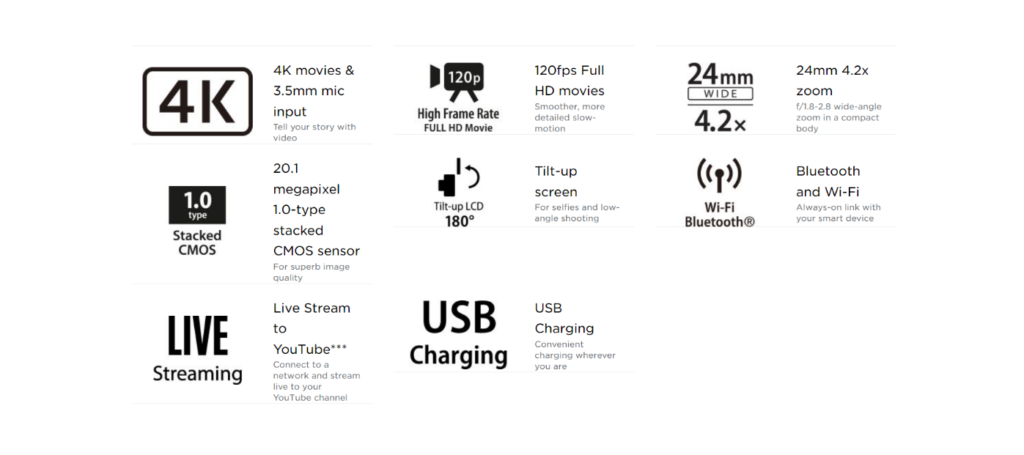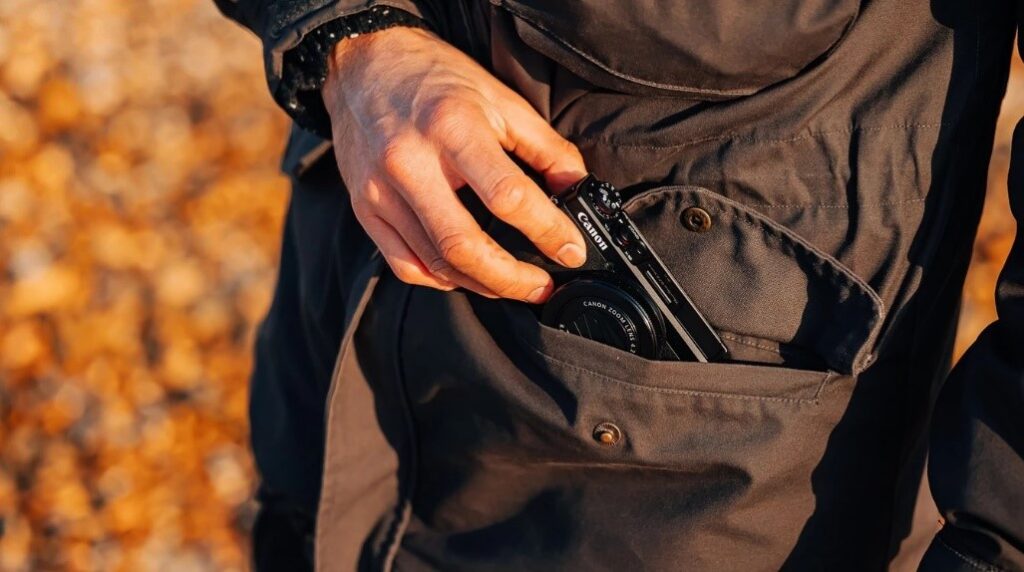Despite advances in smartphone technology, there are still plenty of reasons to use a specialized pocket camera. Pros who often opt for a large camera with interchangeable lenses for more relaxed trips might prefer something smaller. While certain individuals might think that a smartphone is sufficient, the Canon PowerShot G7 X Mark III ($749.99) is a worthwhile camera to consider. if you prefer the grip and ergonomics of a conventional camera.
Although it’s not the best option in the class, this small group is quite competent, also from Canon, which has an EVF and slightly more zoom abilities.

Specification
- Sensor: 1 stacked CMOS, 20.1 megapixels Continuous: 30 frames per second, RAW explosion
- Lens: f/1.8-2.8, 8.8-36.8mm (24-100mm)
- Processor: DIGIC 8 from Canon
- Video: Full HD 120p, 4K 30p
- Screen: 3.0′′ Tilt Touchscreen with about 1,040k dots and a 3:2 aspect ratio
- The measurements are 105.5 x 60.9 x 41.4 mm W x H (4.15 x 2.39 x 1.63 inches).
- 304g (0.67lb) in weight
- Bluetooth & Wi-Fi connectivity
- 5-axis dynamic IS image stabilisation
Important lessons learned
The G7 X III can record raw bursts at a maximum frame rate of 30 fps and save up to 15 pictures that were taken before the shutter is completely released.
The first camera capable of sending live 1080p video over YouTube is this one, but it’s not quite as easy to set up as it could be. The G7 X III has a USB Type-C connector for charging, however, only USB PD chargers can utilize it.

updated processor and sensor:
The 20MP 1″-type sensor in the G7 X Mark III uses a stacked CMOS construction, which is currently unique to Sony cameras. The primary benefit of this sensor architecture is speed: the camera can take bursts at up to 30 frames per second (more about it below).
According to Canon, the Mark III performs better at high ISO than its predecessor because of the Digic 8 processor, which also supplies the power for 4K video. Later in the review, we’ll examine the validity of that assertion.
Raw burst at 30 frames per second
The small and ILC Canon cameras, including the G7 X Mark III, have the ability to capture raw bursts at a rate of thirty frames per second. It may continue to do so for a considerable amount of time, with the camera showing a bar that indicates the buffer capacity on the left side of the screen. When the shutter is halfway pushed, the G7 X III may pre-buffer, saving the fifteen images that were taken before completely pressing the button.
ISO 125 | 1/1000 sec | F5.6 | equivalent to 24 mm.
Barney Britton took the photo
The file names of photos shot in raw burst mode differ from those of photos taken in the ‘ regular’ mode. they are stored in a separate virtual folder on the camera; these photos cannot be accessed on the memory card since they are combined into a single CR3 file. You may take individual photos out of the collection and export them as JPEGs so you can edit them before storing them.
The camera’s use of an electronic shutter to achieve 30 frames per second burst mode may result in banding when exposed to artificial light. Additionally, rolling shutter distortion could be more apparent.
vertical recording of a video
Vertical video recording is a new function that will be incredibly useful for vloggers. Take a few portrait photos, send them directly from the camera to your preferred streaming website, and you won’t need to adjust a thing. It’s surprising that vertical video a frequent use case—cannot be live-streamed.
USB Power Transfer
As USB Power Delivery (USB PD) becomes more prevalent, the G7 X Mark III is among the cameras that enable it. This allows the camera to be operated and charged concurrently when it connects to a USB PD power source, such as a laptop charger or a portable power bank.
If you select to use the USB port on your cell phone or have a standard phone charger lying around, you will most likely not be able to charge the battery in your automobile. Modern power banks and iPad chargers work well; just make sure Power Delivery is supported before making a purchase. Canon is glad to offer you its own USB charger for around $190 if you want to be extra cautious. (We paid $25 for a perfectly good one from Anker.)
The Body, processes, and their implementation

Although it’s not the smallest enthusiast’s compact, the Canon PowerShot G7 X Mark III gets very close. It is relatively simple to slip into a jacket or jeans pocket, and the power button’s placement prevents you from accidentally turning the camera on when it’s hidden away.
Significant lessons learned
The camera maintains the same 24-100mm comparable F1.8-2.8 lens used in previous G7 X series models.
The G7 X III’s display comes with a 180-degree and 45-degree flip feature. One of the best user interfaces available comes from Canon.
The camera can be charged through USB, but only via 3.0-compatible chargers and power banks. Electricity Transfer
Using Canon’s Image Gateway assistance, owners of the camera can upload images to many social media platforms and share pictures on websites.
Body

The PowerShot G7 X Mark III’s lens, which is similar to that of the earlier models in the series, is the highlight of this model. Its lens has a maximum aperture of F1.8–2.8 and corresponds to a 24-100mm lens. We will talk more about the lens’s quality shortly.
The G7 X III has an expensive feel and looks thanks to its robust construction and red accents around the dials on the top plate. There is enough “resistance” in the dials to avoid unintentional movement.
The G7 X III is barely different from its predecessor. Two of the biggest changes are the slightly modified top plate, which now seems to be constructed from plastic instead of metal, and a change in one of the buttons’ work: Ring Funk is now an AE/AF lock.
With a flip of a switch, the G7 X II’s control dial around the lens may be both “click” or “not click.” On the Mark III, it disappeared.
We’ll speak more about the lens’s quality soon.
The G7 X III has an expensive feel and looks thanks to its robust construction and red accents around the dials on the top plate. There is enough “resistance” in the dials to avoid inadvertent movement.
The G7 X III is not very different from its predecessor. Two of the most noticeable changes are the slightly altered top plate, which now seems to be made of plastic instead of metal, and a change in one of the buttons: Ring Func is now an AE/AF lock.
With a flip of a switch, the G7 X II’s control dial around the lens may be both “click” or “not click.” On the Mark III, it disappeared.
It is an odd move considering that the camera is primarily used for capturing videos and that filmmakers prefer not to hear the sound of the dial being turned. Click is preferable while taking stills since it makes it clear when you’ve adjusted a value (such as aperture).
The G7 X III’s 3.2″ LCD, with 1.04 million dots, is typical for its class. It has a 180° upward flip for vlogging or selfies and a 45° downward flip for overhead photography. There is no electronic viewfinder on the G7 X III, in contrast to the RX100 VA and G5 X II. One of the finest touchscreen implementations available is from Canon. Almost everything is dynamic and touch-enabled, including the main menu.
In addition, there are several physical controls. Adjusting shutter speed, aperture, and other settings is made possible via the exposure compensation dial on the top plate, the control ring surrounding the lens, and the still-too-small wheel on the back of the camera (see below).
The pop-up flash on the G7 X III can be manually bounced and has a range of up to 7.5m (maybe at Auto ISO).
The camera has three ports: USB and HDMI on one side, and a microphone input on the left. The USB port has a Type-C connector, although USB 2.0 transfer rates apply. To charge via USB, you need the appropriate equipment, as was indicated on the page before. Thank goodness, Canon comes with an external charger.
The battery used in the G7 X III is the well-known NB-13L. The Mark III’s CIPA-rated value of 235 shots indicates a 10% decrease in battery life when compared to its predecessor, maybe because of the redesigned image processor and/or sensor. If you restrict your usage of Wi-Fi and video capture (not to mention streaming), you’ll be able to snap a lot more pictures in real life than that.
The camera’s SD card slot, which is compatible with UHS-I media, is located beneath the same door as the battery.
Handling Canon Powers hot G7 X Mark III

We found the Canon Powershot G7 X Mark III a pleasant camera to carry and use. In some ways, the camera feels more durable than the more expensive G5X II. since it features a mix of plastic and metal parts and a large, clinging rubber grip at both the front and the back.
(*The lens control ring feels better and the rear of the G7X III is constructed of metal.)
Its touch-screen provides additional choices and oversight, which makes it easy to modify settings as needed. The structure of the controls is clean and easy to understand. Clicking the Q-Menu button shows multiple choices.
Because the menu framework is the same as that of Canon EOS DSLRs, consumers who use the camera as a backup or replacement for a Canon EOS camera. should be extremely comfortable with all of the available options. In addition, a “My Menu” area allows you to quickly find your preferred choices.
Customizing the control ring around the lens is an easy way to make rapid adjustments; however, it makes a loud clicking sound when changed, so it’s best not to use it while shooting (you can’t turn this off, unlike the G7X II, which provided you the choice). In addition, the 4-way is enclosed by a scroll wheel. and doing so provides easy access to the flash, drive mode, and focus settings. Both the * (AE Lock) button and the movie record button are customizable.
Review the Canon Powershot G7 X III: G7 X Mark III
The 3-inch touch screen has a resolution of 1040K dots and is vibrant and clear. It’s great for “vlogging” while taking selfies since the screen shifts forward, but if you need it, the pop-up flash can a bit obscure your view. The focus point can be set via the touch screen, and it can be anywhere on the screen, even in the far corners. There are 49 AF points, and even though they do not include eye detection, face detection works efficiently.
The camera will reconnect to Wi-Fi when you use it for remote shooting, but you can also use Bluetooth or Wi-Fi to link it to your smartphone or tablet. Additionally, you have the option to link the camera to your personal WiFi network. After that, you may use Canon Image Gateway to configure the camera so that images are uploaded to both Canon’s website and other websites, such as YouTube and Twitter.
Review of the Canon Powershot G7 X III: G7 X Mark III
Battery life: According to Canon and CIPA test results, the battery life is rated at 265 shots, which is about average for a small camera. With the ECO mode, this can be increased to 320 photos, but purchasing the battery pack—which contains a second battery—is what we’d advise. A USB Type-C connection is provided.
You’re able to use the USB Type-C connection to power the camera while it’s in use or to charge the battery inside the camera.
Modifications and menus

The G7 X III’s menu system is the same as that of previous models, and that’s fine because those choices are already outstanding. Every part within the main menu, which includes stills, playback, wifi, setup, and a customizable “My Menu,” is clearly separated by colored tabs.
The Menu brings the most frequently utilized settings to your fingertips It can be opened by pressing the appropriately named Q/Set button on the back of the device. This particular menu cannot be altered.
In terms of personalization, there are five controls that you may modify: the front and back dials, the movie, the AE/AF lock, and the shutter release buttons. There are just two options for the shutter release: AF start on half push (or not), and the back dial, which is usually off or mode-dependent (which is referred to as “standard”).
Auto-ISO
Whenever it comes to Auto ISO, Canon offers a wide range of environments. Along with selecting the minimum shutter speed and an ISO range the camera will use, you may also tell the camera to select a shutter speed based on the length of the lens or to bias this choice towards a slower rate (if you’re confident you can keep the camera steady) or a faster speed (if you’re trying to freeze action).
Auto ISO is suitable for exposure revision in all video capture modes and can also be used in stills (‘M’ mode).
Quality of picture


Except for the G7 X III, nearly every one of the contemporary Sony RX cameras has a sensor identical to that utilised by the G7 X III, indicating that differences in picture quality are primarily attributable to lens quality.


Significant lessons learned
The G7 X III’s raw detail capture and noise reduction capabilities are on par with, if not better than, those of its competitors. Canon digital cameras are known to produce vivid colour representations in JPGs.
JPEG sharpening has improved over previous G7 X models, but noise reduction is still somewhat high, especially at high ISOs.
The wide-angle lens of the G7 X III is a bit soft, yet as the focal length is increased, it sharpens well.
raw performance
Assessing the G7 X III’s performance at its sharpest point, at the long end of its lens, we found that the camera performs on par with its rivals. The G7 X III has the ability to capture even more fine detail in raw pictures than the similar Sony DSC-RX100 V (or at least our copy of it). At the highest sensibility, noise levels are similar to those of the G7 X III’s parallels, though we doubt that many people will be using these cameras for taking pictures at ISO 6400 or greater.
See our PowerShot G5 X II review for more information on the dynamic range of the G7 X Mark III. The results ought to be the same since it utilizes the same sensor. It will be possible for you to improve shadows (to a certain degree) without excessively caring about noise.
Video:
The G7 X III has decent video capabilities generally, yet it’s great for vlogging due to its mic socket, vertical video compatibility, and live streaming function (which is covered in more depth here). With the movie set off or on low, it can record 4K/30p video in its entirety, with cropping. Although some G7 X III users complained of overheating, we never experienced this issue. There is a 10-minute time limitation.
At the time of publication, the camera had no 24p performance, which many filmmakers find important. But Canon said that it will be releasing a firmware improvement with assistance for 24P by the end of 2019.
The star time-lapse on the camera was employed to gather the video footage for this hour-long movie.
Apart from 4K, the G7 X III can also record video in 1080/60p, 30p, and their PAL equivalents. It also has a fast 120p mode that calls for focus manipulation alone. It includes several time-lapse modes, one dedicated to star photos.
The star time-lapse on the camera was employed to gather the video footage for this hour-long movie.
Apart from 4K, the G7 X III can also record video in 1080/60p, 30p, and their PAL equivalents. It also has a fast 120p mode that calls for focus manipulation alone. It includes several time-lapse modes, one dedicated to star photos.
Autofocus and quality of video

We’ll utilize instances from the G5 X II to clarify the video performance and quality of the G7 X III since, other than their lenses, they’re the same camera.
Video footage of our studio scenario shows clearly that the level of detail capture of the Sony RX100 V is simply unmatched by the G5 X II (and consequently the G7 X III).
This is mainly brought about by the softness of the camera’s lens and how the G7 X III samples its sensor for video.
The movie becomes extremely soft when Canon’s progressively greater image stabilization levels are employed, and the ‘high’ choice appears awful. On the Canon, reducing the resolution to 1080p doesn’t seem all that outstanding either.
See if the video quality between the LG G5 X II and the Sony RX100 V compares.
The G7 X III uses contrast-detect concentrating in footage, just as it does for still images, putting it behind cameras that utilize phase-detection, like the Sony RX100 V.
After severe condemnation of the camera’s video AF performance in earlier reviews, Canon released an update to the firmware that improves the subject tracking abilities.
To verify the camera’s efficiency with the upgraded firmware, we ran it through an ordinary vlogging situation:
The G7 X III works OK overall, whereas the frequent searching of the CDAF system is irritating. The best area for noticing this is at the start, so look out to the ceiling lights or columns decorated with yellow on the opposite side. This picture also has an important amount of “jelly” effect because of the camera’s “standard” IS setting.
Considering the loud surroundings, the audio captured with the integrated microphone sounds OK.
stabilisation of videos
In addition to utilizing its in-lens stabilization, many digital IS settings include off, low, standard, and high. As has been shown, the lowest setting produces no additional harvest; on the contrary, the standard and high settings yield crops of 1.11x and 1.43x, respectively.
Here is an overview of the operation of all of the IS modes on the G5 X II, the sister model of the G7 X III:
Canon G7X Mark III Review and Description
Using this camera, Canon intends to appeal to two audiences: people who want to switch from an intelligent cell phone to a “real” camera. those who are passionate about vlogging and creating video content for YouTube.
Fortunately, a much-needed software update fixed some very bad focusing issues seen with video. which happens to be this camera’s primary selling point.
The Canon G7X Mark III is an excellent option due to its solid build, extensive stills and video capabilities, and some extremely intelligent connection choices.
Despite video bloggers and YouTubers, the G7X would be ideal for travelers or anyone who just wants an easy-to-use everyday camera for snapping pictures of their family.
Considering the popularity of YouTubers and video bloggers, vacationers or anyone looking for an ordinary, everyday camera to take family photos would find the G7X to be ideal.
ALSO READ: Nikon coolpix! best point & shoot camera?




